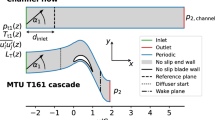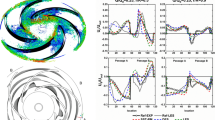Abstract
The interaction of a laminar boundary layer with a shock wave at a Mach number M = 1.43 is studied by numerical simulation. The results obtained by direct numerical simulation are compared with the results of calculations using the Reynolds-averaged Navier–Stokes (RANS) equations supplemented with different turbulence models describing laminar–turbulent transition. The possibility of determining the position of the flow turbulence zone based on linear stability theory and the \(\mathrm{e}^{N}\)-method is estimated. Comparison of the numerical simulation with experimental data shows that engineering RANS methods can be used to study supersonic flows in which transition to turbulence occurs in regions of shock wave–boundary layer interaction.







Similar content being viewed by others
REFERENCES
J. Green, “Interactions between Shock Waves and Turbulent Boundary Layers," Progr. Aerospace Sci. 11, 235–340 (1970).
D. S. Dolling, “Fifty Years of Shock Wave/Boundary Layer Interaction: What Next," AIAA J. 39, 1517–1531 (2001).
A. J. Smits, Turbulent Shear Layers in Supersonic Flow, Ed. by A. J. Smits and J. P. Dussauge (Woodbury, New York, 1996).
A. Zheltovodov, “Shock Wave/Turbulent Boundary Layer Interactions: Fundamental Studies and Applications," AIAA Paper No. 1996-1977 (New Orleans, 1996).
Y. Andreopoulos, J. H. Agui, and G. Briassulis, “Shock Wave–Turbulence Interactions," Annual Rev. Fluid Mech.32, 309–345 (2000).
H. Babinsky, Shock Wave–Boundary-Layer Interactions, Ed. by H. Babinsky and J. K. Harvey (Cambridge Univ. Press, 2011).
Unsteady Effects of Shock Wave Induced Separation, Ed. by P. Doerffer, C. Hirsch, J.-P. Dussauge, et al. (Springer, 2011). (Notes Numer. Fluid Mech. Multidisciplinary Design; Vol. 114.)
N. T. Clemens and V. Narayanaswamy, “Low-Frequency Unsteadiness of Shock Wave/Turbulent Boundary Layer Interactions," Annual Rev. Fluid Mech. 46, 469–492 (2014).
D. Di Pasquale, A. Rona, and S. Garrett, “A Selective Review of Transition Modeling for CFDs," (AIAA Paper No. 2009-3812) (San Antonio, 2009).
D. Knight and G. Degrez, “Shock Wave Boundary Layer Interactions in High Mach Number Flows: A Critical Survey of Current CFD Prediction Capabilities," Tech. Report No. AR-319-02 (Advisory Group for Aerospace Research and Development, Neuilly-sur-Seine, 1998).
S. Teramoto, “Large-Eddy Simulation of Transitional Boundary Layer with Impinging Shock Wave," AIAA J. 43 (11), 2354–2363 (2005).
E. Touber and N. D. Sandham, “Large-Eddy Simulation of Low-Frequency Unsteadiness in a Turbulent Shock-Induced Separation Bubble," Theor. Comput. Fluid Dyn. 23, 79–107 (2009).
E. Garnier, P. Sagaut, and M. O. Deville, “Large Eddy Simulation of Shock/Boundary Layer Interaction," AIAA J. 40 (10), 1935–1944 (2002).
S. Pirozzoli and F. Grasso, “Direct Numerical Simulation of Impinging Shock Wave/Turbulent Boundary Layer Interaction at M = 2.25," Phys. Fluids 18 (6), 065113 (2007).
M. Wu and P. Martin, “Direct Numerical Simulation of Supersonic Turbulent Voundary Layer over a Compression Ramp," AIAA J.45 (4), 879–889 (2007).
C. Mayer, D. von Terzi, and H. Fasel, “Direct Numerical Simulation of Complete Transition to Turbulence via Oblique Breakdown at Mach 3," J. Fluid Mech. 674, 5–42 (2011).
I. V. Egorov, A. V. Novikov, and A. V. Fedorov, “Direct Numerical Simulation of the Laminar–Turbulent Transition at Hypersonic Flow Velocities on a Supercomputer," Zh. Vychsil. Mat. Mat. Fiz.57 (8), 1347–1373 (2017) [Comput. Math. Math. Phys.57, 1335–1359 (2017); https://doi.org/10.1134/S0965542517080061].
A. N. Kudryavtsev and D. V. Khotyanovsky, “Direct Numerical Simulation of Transition to Turbulence in a Supersonic Boundary Layer," Teplofiz. Aeromekh. 22 (5), 581–590 (2015) [Thermophys. Aeromech. 22 (5), 559–568 (2015); https://doi.org/10.1134/S0869864315050042].
D. V. Khotyanovsky and A. N. Kudryavtsev, “Numerical Simulation of the Evolution of Unstable Disturbances of Various Modes and Initial Stages of the Laminar–Turbulent Transition in the Boundary Layer at the Freestream Mach Number M = 6," Teplofiz. Aeromekh.23 (6), 843–852 (2016) [Thermophys. Aeromech.23 (6) 809–818 (2016); https://doi.org/10.1134/S0869864316060032].
P. A. Polivanov, A. A. Sidorenko, and A. A. Maslov, “Transition Effect on Shock Wave/Boundary Layer Interaction at M = 1.47," AIAA Paper No. 2015-1974 (Kissimmee, 2015).
P. A. Polivanov and A. A. Sidorenko, “Suppressing a Laminar Flow Separation Zone by Spark Discharge at Mach Number M = 1.43," Pis’ma Zh. Tekh. Fiz. 44 (18), 60–68 (2018) [Tech. Phys. Lett. 44, 833–836 (2018); https://doi.org/10.1134/S1063785018090262].
P. A. Polivanov, A. A. Sidorenko, and A. A. Maslov, “The Influence of the Laminar–Turbulent Transition on the Interaction between the Shock Wave and Boundary Layer at a Low Supersonic Mach Number," Pis’ma Zh. Tekh. Fiz. 41 (19), 29–37 (2015) [Tech. Phys. Lett. 41, 933–937 (2015); https://doi.org/10.1134/S1063785015100120].
A. I. Kutepova, P. A. Polivanov, and A. A. Sidorenko, “Effect of a Uncertainties of Flow Parameters on the Separation Zone at Supersonic Speeds," J. Phys.: Conf. Ser. 1404, 012085 (2019); DOI: 10.1088/1742-6596/1404/1/012085.
P. A. Polivanov, A. A. Sidorenko, and A. A. Maslov, “Study of the Unsteady Structures Evolution in Shock Wave/Boundary Layer Interaction for Various Upstream Conditions," in Proc. of the 30th Congr. of the Int. Council of the Aeronautical Science (ICAS 2016), Daejeon, Korea, September 25–30, 2016, pp. 1–10.
A. V. Boiko, K. V. Demyanko, A. A. Inozemtsev, et al., “Determination of the Laminar–Turbulent Transition Location in Numerical Simulations of Subsonic and Transonic Flows Past a Flat Plate," Teplofiz. Aeromekh. 26 (5), 675–683 (2019) [Thermophys. Aeromech. 26 (5), 629–637 (2019); https://doi.org/10.1134/S0869864319050019].
Author information
Authors and Affiliations
Corresponding author
Rights and permissions
About this article
Cite this article
Polivanov, P.A., Khotyanovsky, D.V., Kutepova, A.I. et al. INVESTIGATION OF VARIOUS APPROACHES TO THE SIMULATION OF LAMINAR–TURBULENT TRANSITION IN COMPRESSIBLE SEPARATED FLOWS. J Appl Mech Tech Phy 61, 717–726 (2020). https://doi.org/10.1134/S0021894420050053
Received:
Published:
Issue Date:
DOI: https://doi.org/10.1134/S0021894420050053




